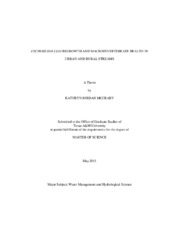| dc.description.abstract | Over the last few decades, increased urbanization has led to a new recognition in stream health – the urban stream or the urban stream syndrome. Understanding urban water quality is important for identifying those factors or sources that contribute to impairment. Many streams are listed as impaired because of the increased concentrations of pathogens. While wastewater treatment plants (WWTPs) discharge effluent that has been disinfected, often downstream from WWTPs point sources are high numbers of indicator bacteria, Escherichia coli. This study collected data on the recovery and regrowth of E. coli by collecting ultraviolet light treated effluent from the Carters Creek WWTP and spiked it with three different concentrations of DOC derived from a leaf and grass extract. Escherichia coli were enumerated at 6, 12, 18, 24, 36, 48, and 72 hours. After 6 h growth for each of the grass treatments, except for the control and high grass treatment exceeded the primary contact recreation standard for surface water quality. At 18h the low and high leaf treatments exceeded the primary contact recreation standard for surface water quality. The chemistry of each flask was analyzed for DOC, total N, NO3-N, NH4-N, Na , K , Mg 2, Ca 2, F-, Cl-, SO4-2 and PO4-3 at t=0 and t=72 h. CNP values for both leaf and grass treatments ranged from 2.22 - 36.5. Regrowth was not observed in those treatments with a CNP value below 5. Biodegradability of the treatments was examined to identify the limiting nutrient. By focusing on reducing the CNP value below 5 of the receiving water, recovery and regrowth of E. coli downstream from WWTPs can be reduced. The biodegradability test suggested that in the presence of excess DOC, N is the limiting nutrient.
Certain macroinvertebrate species, Ephermeroptera, Trichoptera, and Plecoptera (EPT), are indicators of good stream health. Macroinvertebrates were collected at nine watersheds within the Bryan/College Station area, a rapidly urbanizing community, upstream and downstream from WWTPs and analyzed for relative abundance of pollution intolerant (percent EPT) and pollution tolerant species. All sites downstream from a WWTP had percent EPT present in the collection. | en |


